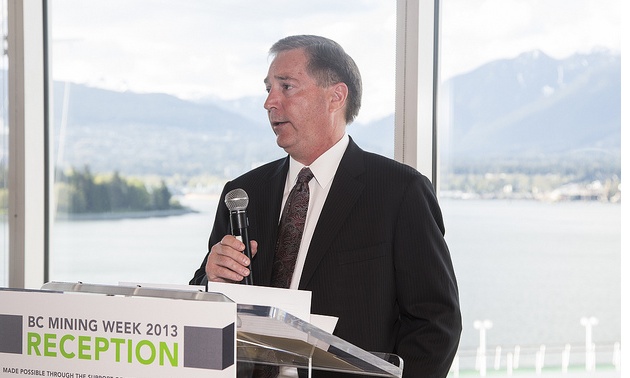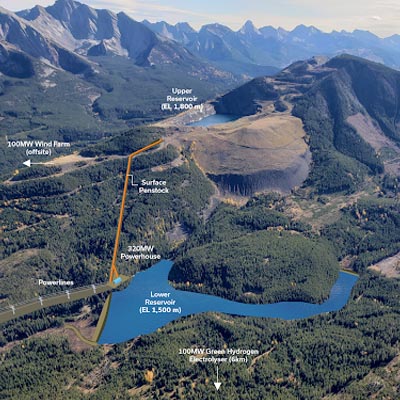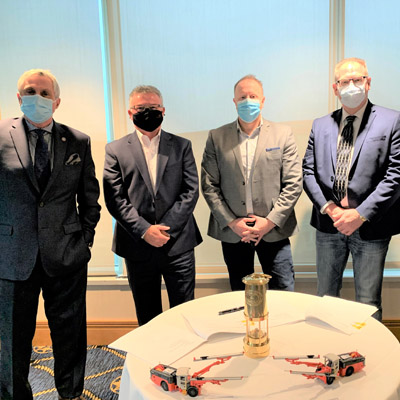MSABC sends the message that mining builds communities
B.C.’s mining industry directly employed over 9,300 people across the province in 2012

Bruce Knight, president and CEO of SMS Equipment, at the opening ceremony of BC Mining Week 2013. SMS Equipment and other mining supplier companies contributed to Mining Week events held in communities across the province. — Photo courtesy Flora Gordon
For every person employed in a mining operation, two jobs are created in services, suppliers, or support positions related to the industry. This is one of the key messages the Mining Suppliers Association of B.C.’s (MSABC) hopes to carry forward from Mining Week’s “Mining Builds Communities” campaign held earlier this spring.
The association’s efforts to create awareness about the broad reach of mining operations in B.C. is focused primarily on illustrating the diversity of services and far reach of mining operations beyond those working on site.
“For communities located in close proximity to a mine the indirect economic benefits of mining operations are relatively easy to see, as many local businesses provide supplies and services to sustain those operations,” says MSABC chairperson Mike Ranallo. “Not only do they see the more obvious mining-related purchases, such as heavy equipment, fuel, and contracted transportation, but local businesses also see the smaller spin-off benefits, from the purchasing of toilet paper and computer software to the mine workers’ spending at local restaurants.”
For British Columbians living farther away these benefits are less obvious, he adds. “Along with environmental impacts and other social considerations, the full economic benefits of mining operations should be understood as British Columbians deliberate on where, when, and how to develop new responsible mining operations.”
B.C.’s mining industry directly employed over 9,300 people across the province in 2012, and according to a report from PriceWaterhouseCooper, the industry supported more than 37,000 direct and indirect jobs in 2011. Hiring requirements for all provincial mining sectors are expected to be 16,770 over the next ten years.
Mining presents a highly beneficial contribution to the province
With over 900 service and supply companies supporting more than 1,200 mineral exploration and mining companies across the province, mining presents a concerted, highly beneficial contribution to even the most remote communities in the province.
According to MSABC’s literature, a prime example is the Copper Mountain Mine near Princeton, which had a feasibility study prepared by an engineering firm in Vancouver, conveyor systems supplied by a company in Surrey, belting from a firm in Burnaby, explosives from a company in Williams Lake, fuel and steel balls from companies in Kamloops, and haul truck tires from a company with a head office in Vernon.
The industry also represents employment and charity benefits to surrounding communities. It holds the best safety record in all of B.C.’s heavy industries, and pays one of the highest annual salaries. It represents 4.5 percent of the provinces GDP and supports several training, educational, and charitable causes including the BC Children’s Hospital, which has received more than $20 million as part of the Mining for Miracles campaign. It is also the largest private sector employer of First Nations in B.C., committed to mineral tax revenue sharing programs for new and expanding mines.
Importance of mining in our daily lives
A key priority of mining industry associations like MSABC is ensuring people remain aware of the importance of mining in their daily lives, from eating breakfast with a metal spoon to reading emails on a smartphone while riding the bus to work, says Ranallo. “We all should know about the wide-range of uses for the metals and minerals produced by the mining industry in BC,” he says.
“Our copper is used for wires in electric cars. Our molybdenum strengthens the steel used in buildings. Our gold is used as a currency and in electronics. Our metallurgical coal is used to make the steel needed for wind turbines, and the list goes on. If you can’t grow it you have to mine it.”




